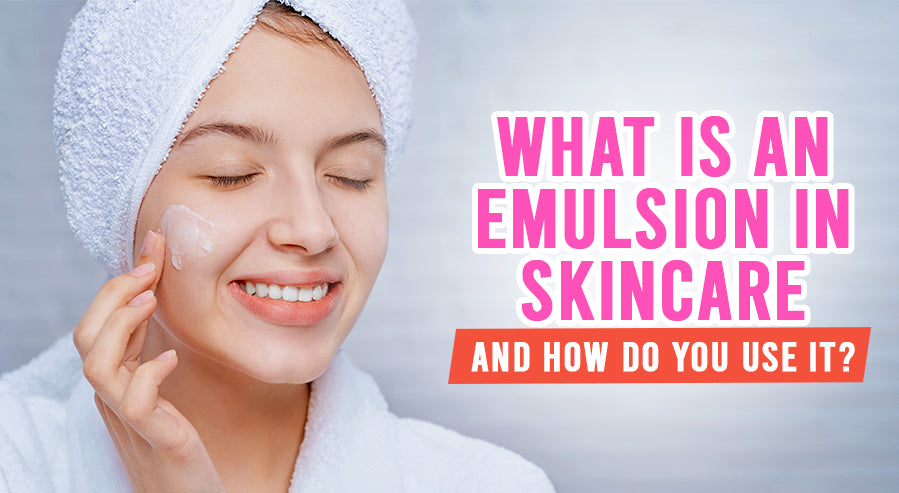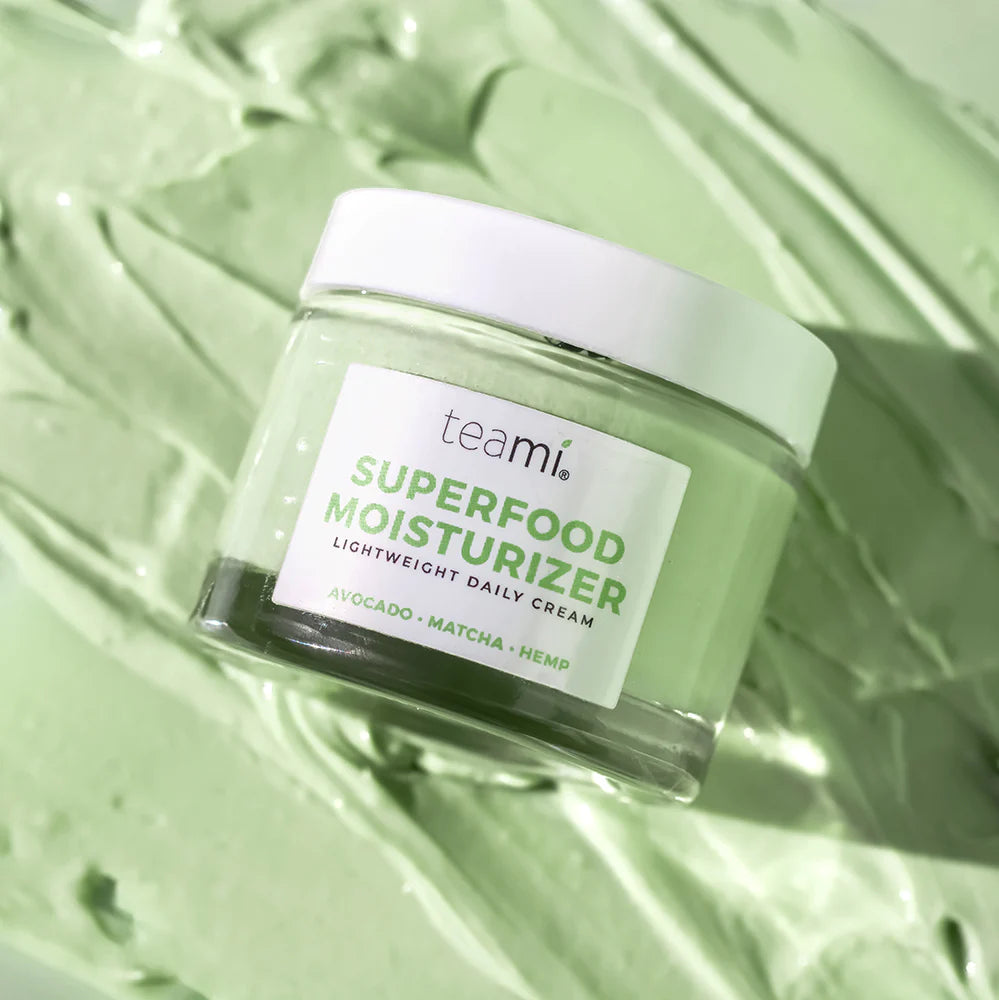What is an Emulsion in Skincare, and How Do You Use It?

The sheer number of skincare products on the market can make it almost impossible to track what is what. Some products are well understood, while others are slightly vaguer and not commonly understood by the general public. It usually takes a while for someone to reach the level of "expert" insofar as cosmetics are concerned.
People with a history of advanced skincare routines likely know most of the products by heart, but newcomers might struggle to keep track of what is a valuable product. A lack of knowledge about skincare products is not something to be ashamed of, especially since cosmetics brands are constantly marketing new products. The problem is that this lack of knowledge can cause you to misuse products and do more damage to your skin.
One of the most confusing products on the market is emulsions, which are doubly obscure since their purpose is unclear and their names are somewhat complex. As a result, individuals beginning a skincare routine for the first time might struggle to understand what they are and how they are used. Considering how sensitive our skin is, the inability to use an emulsion properly can compromise your skin's health rather than enhance its appearance.
Therefore, one of the first things you must do before starting a new skincare routine is learn what an emulsion is so you do not introduce a harmful product to your skin.
What is an Emulsion?
The term "emulsion" is rooted in chemistry and refers to a somewhat complicated liquid. Emulsions are mixtures of at least 2 liquids that are normally immiscible (meaning they are normally unmixable) due to a concept called liquid-liquid phase separation. The most notable example of an immiscible combination is oil and water, in which the two cannot mix, and the oil instead rests on top of the water.
This state is the first stage of a potential emulsion since the substances involved are not supposed to mix without outside intervention. These substances are artificially mixed to create a single liquid but are unstable since the two are not meant to be combined. As a result, the mixture will usually separate itself after a certain time, though the details of this are determined by the contents rather than the nature of an emulsion. Regardless, emulsions must be stabilized before they can be sold to avoid the product's ingredients separating before it can be used.
The stabilization agents of an emulsion are called emulsifiers and are usually found in several compatible ingredients. The emulsifier reduces the oil-water interface tension, a process by which liquid shrinks to the smallest possible molecule that causes heavier substances to float. The emulsifier prevents this from happening, so the denser substance mixes with the liquid rather than floating to the surface again.

Some emulsifiers are more common than others, but most are used for specific products to maintain consistency. For example, mono- and diglycerides are emulsifiers primarily used in coffee creamers, ice cream, spreads, bread, and cakes. Other emulsifiers are more easily accessible, such as egg yolks and mustard. That said, finding the right emulsifier for the product you are trying to create takes a little research and effort.
Fortunately, people looking for skincare products do not necessarily have to concern themselves with which emulsifier was used in the product, though you should look for the following:
- Polysorbates
- Laureth-4
- Potassium Cetyl Sulfate
These emulsifiers are among the most commonly used for skin care products and were chosen because they synergize with the ingredients used in such products. This brings us to the question of what an emulsion is in the context of skincare treatments. In the skincare industry, an emulsion is a type of water-based moisturizer that uses other ingredients to make a light, milky cream.
Emulsions are typically an alternative to traditional skin creams and oils because they are lighter and do not yield the same sensations as heavier products. Emulsions can yield a wide variety of effects depending on the ingredients used and are generally designed to improve blemishes on the skin.
Acquiring an emulsion can be an excellent step on your skincare journey, but it does not change that you must learn how to use it. This can be tricky if you are still learning to plan your skincare routine, but using an emulsion is not overly difficult.
How to Use an Emulsion
Emulsions are essentially lighter skin creams that are consistent with gel, which should be familiar if you use body wash in the shower. The difference is that emulsions are less heavy than traditional skin creams, meaning there is less pressure after application. Some emulsions are similar to sprays that share those benefits. Emulsions are skincare products specifically designed for comfort and convenience and can be added to any skincare routine.
Applying an emulsion will vary depending on whether you have the spray or the gel, which is hardly surprising considering how each product type is used. If you have the gel, applying an emulsion is as simple as dabbing a few dots on your cheeks, nose, chin, and forehead. From there, you need only massage the product into your skin so it can take hold and improve your skin's moisture.

For a spray, you should apply small spritzes to the same areas and allow them to dry without massaging. That said, spray emulsions are rare since the gels are more effective in many circles. If you are still establishing a routine, there is another detail you must consider when using an emulsion. Skincare routines are very particular concerning when to apply a product, leading to a hierarchy of skincare products that must be followed. The general rule is to start with the lightest products and work toward the heaviest.
Additionally, you must ensure that any skincare products with a low pH are applied before products with a neutral or high pH value. Insofar as emulsions are concerned, there is conflicting information about when to apply them. Some claim an emulsion should be applied at the beginning of your routine since it is one of the lightest skincare products. Others say it must be applied at the end of the routine to ensure it has time to be absorbed.
Ultimately, it seems that the application of your emulsion should be timed by personal preference, but there is one caveat that everyone agrees with. An emulsion should always be applied after a toner and before a moisturizer since it synergizes with both products. Therefore, if you want to incorporate emulsions into your routine, schedule it between your toner and moisturizer.
Why Use an Emulsion?
Using an emulsion might be simple, but one question might be at the forefront of your mind. Emulsions are cited as a highly effective cosmetic tool, but you might be curious about why it is used. Emulsions are used to moisturize and rehydrate the skin, an extremely pressing concern for anyone who takes pride in their appearance. One of the most common problems we face is dry skin, which can manifest for several reasons. Dry skin, clinically called xerosis or xeroderma, can cause various unpleasant symptoms that make it difficult to feel comfortable in our skin. Dry skin can cause the following issues:
- Tightness of the skin.
- Pruritis (itchy skin).
- Flaking, peeling, or scaling skin.
- Cracked skin.
- Redness of the skin.
Other symptoms manifest in severe cases but are all painful or uncomfortable. Also, dry skin is easy to develop because our skin is constantly exposed to the elements. One of the primary purposes of human skin is to protect us from environmental hazards like wind and heat, allowing our internal organs to thrive. The problem is that overexposure to certain elements can cause our skin to dry out. We are also susceptible to health issues that can dry our skin as a side effect. The main causes of dry skin include:
- Heat: Dry heat from stoves, fireplaces, space heaters, or arid climates reduces the humidity of our environment. As a result, there is less moisture in the air for our skin to absorb, and our body's natural moisturizing agents are dried out as a side effect. This can cause our skin to dry and induce some of the more severe symptoms if we spend too much time in these climates.
- Wind: Windy environments can be just as detrimental to our skin's moisture because the force of the wind can strip away the sebum that we excrete to moisturize our skin. Furthermore, windy environments tend to be less humid, though not as much as arid climates.
- Excessive Bathing: Polite society dictates that we bathe regularly using hot water and soaps to cleanse our bodies of dirt and sweat. While this is healthy, taking too many hot showers or baths can dry our skin since the warm liquid absorbs our moisturizing agents and dries our pores. Bathing more than once a day strips the natural oils our bodies produce and prevents them from receiving the proper moisturization.
- Soaps and Detergents: Another important facet of bathing is using soaps and body washes to purge the dirt from our bodies. Additionally, we use detergents to cleanse our clothes the same way. These soaps and detergents can have harsh ingredients that destroy the sebum on our skin and strip away existing moisture.
- Skin Conditions: Several skin conditions induce dryness as a byproduct of their main symptoms. One of the worst skin conditions is eczema, infamous for causing dry skin.
- Medical Treatments: Certain medical treatments are intense enough to induce unpleasant side effects. Some treatments are more intense than others (i.e., cancer treatments, dialysis, and certain medications) and can cause our skin to dry and thicken.
Dry skin is an extremely common problem, and the number of causes is not shrinking any faster. As a result, products designed to moisturize the skin when the body's natural process is compromised or insufficient for the task are becoming more popular. Emulsions are one of these moisturizing products and have recently grown in popularity due to their light sensation and easy use.

Some claim that emulsions are poised to replace common moisturizers entirely, but most experts claim that emulsions work best when combined with moisturizers. Emulsions can be used to fill the entire role of a moisturizer, but these stronger emulsions usually lose their light touch and become more akin to traditional moisturizers.
Some emulsions are close enough to moisturizers that even experienced skincare experts struggle to distinguish them from each other. Regardless, using an emulsion can radically enhance your skincare routine and provide the moisturization your skin needs to stay healthy and attractive. The trick is finding an emulsion that takes advantage of the best ingredients and comes from a reliable vendor.
Finding the Right Blend
Emulsions might not be one of the older skincare products, but they have recently developed a positive reputation for their moisturizing effects. While you should combine emulsions with traditional moisturizers for the best effects, some emulsions are just as powerful. The problem is that these stronger emulsions might feel more like a moisturizing cream than the light emulsions discussed in this article.
Nevertheless, these emulsions are worth the effort because they can reinforce other moisturizing products without oversaturating your skin. The biggest challenge in skincare is finding reliable products from trustworthy vendors, which has become more difficult due to the growing number of cosmetics brands.
We at Teami know that finding cosmetics products that meet your specific needs can be a lottery, especially with so many brands advertising their product. Most modern cosmetics products contain harsh pharmaceutical ingredients that can overwhelm people with sensitive skin. That is why we have created a large catalog of health and beauty products that focus on natural ingredients from plant life.

One of the main products we offer is our Superfood Moisturizer, Lightweight Daily Cream, which focuses on the natural effects of matcha to moisturize and restore the skin. While technically a moisturizer, our product is closer to an emulsion and bears the same lightweight feel that other emulsions provide. We encourage you to visit our website to try our product yourself. After all, finding the right blend is a Teami effort.
Subscribe to our Newsletter
Subscribe to our newsletter and get 10% off your first purchase
 Instagram
Instagram



